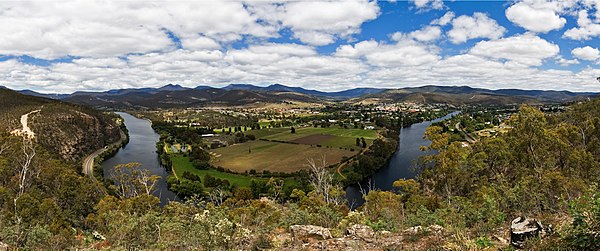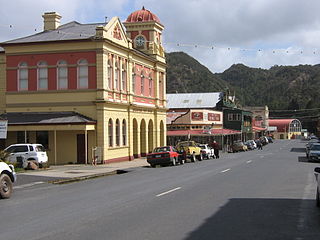It has been requested that the title of this article be changed to New Norfolk . Please see the relevant discussion on the discussion page. Do not move the page until the discussion has reached consensus for the change and is closed. |
| New Norfolk Tasmania | |
|---|---|
 New Norfolk town in Autumn | |
| Coordinates | 42°46′58″S147°03′34″E / 42.78278°S 147.05944°E Coordinates: 42°46′58″S147°03′34″E / 42.78278°S 147.05944°E |
| Population | 5,230 (2006 census) [1] |
| Postcode(s) | 7140 |
| Location |
|
| LGA(s) | Derwent Valley Council |
| State electorate(s) | Lyons |
| Federal Division(s) | Lyons |
New Norfolk is a town on the Derwent River, in the south-east of Tasmania, Australia. At the 2011 census, New Norfolk had a population of 5,543. [1]

Tasmania is an island state of Australia. It is located 240 km (150 mi) to the south of the Australian mainland, separated by Bass Strait. The state encompasses the main island of Tasmania, the 26th-largest island in the world, and the surrounding 334 islands. The state has a population of around 526,700 as of March 2018. Just over forty percent of the population resides in the Greater Hobart precinct, which forms the metropolitan area of the state capital and largest city, Hobart.

Australia, officially the Commonwealth of Australia, is a sovereign country comprising the mainland of the Australian continent, the island of Tasmania and numerous smaller islands. It is the largest country in Oceania and the world's sixth-largest country by total area. The neighbouring countries are Papua New Guinea, Indonesia and East Timor to the north; the Solomon Islands and Vanuatu to the north-east; and New Zealand to the south-east. The population of 25 million is highly urbanised and heavily concentrated on the eastern seaboard. Australia's capital is Canberra, and its largest city is Sydney. The country's other major metropolitan areas are Melbourne, Brisbane, Perth and Adelaide.
Contents
- History
- Before European Settlement
- Resettlement of Norfolk Islanders
- Later history
- Transport
- Tourism
- Climate
- See also
- References
- Further reading
- External links
Situated 32 kilometres (20 mi) north-west of Hobart on the Lyell Highway, New Norfolk is a modern Australian regional centre which retains evidence of its pioneer heritage. Two examples of this heritage are Tasmania's oldest Anglican church, St. Matthews (built in 1823) and one of Australia's oldest hotels, The Bush Inn (Tasmania), trading continuously in the same building (built in 1815) since issue of the first licence on 29 September 1825. [2] Many private homes from the 1820s have also survived, such as Glen Derwent, Valleyfield, and Woodbridge.

Hobart is the capital and most populous city of the Australian island state of Tasmania. With a population of approximately 225,000, it is the least populated Australian state capital city, and second smallest if territories are taken into account. Founded in 1804 as a British penal colony, Hobart, formerly known as Hobart Town or Hobarton, is Australia's second oldest capital city after Sydney, New South Wales. Prior to British settlement, the Hobart area had been occupied for possibly as long as 35,000 years, by the semi-nomadic Mouheneener tribe, a sub-group of the Nuennone, or South-East tribe. The descendants of these Aboriginal Tasmanians often refer to themselves as 'Palawa'.

The Lyell Highway is a highway in Tasmania, running from Hobart to Queenstown. It is the one of two transport routes that passes through the West Coast Range, the other being the Anthony Road (B28).
















